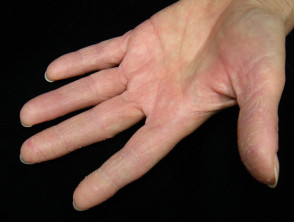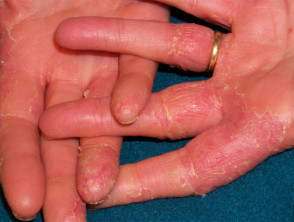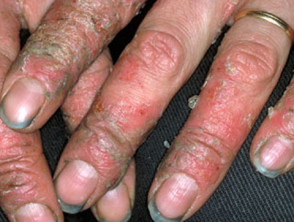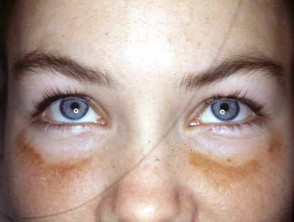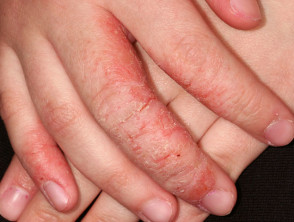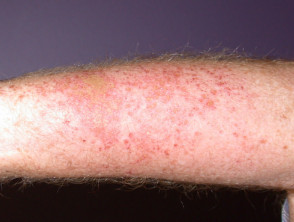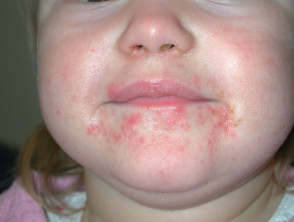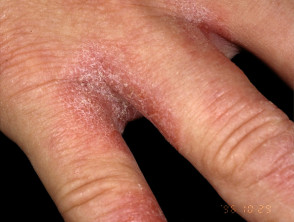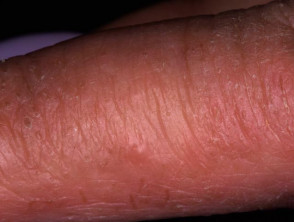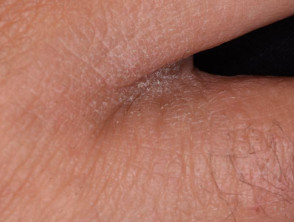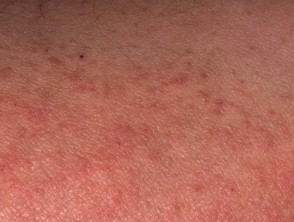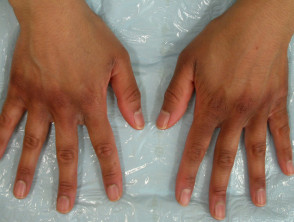What is irritant contact dermatitis?
Irritant contact dermatitis is a form of skin inflammation caused by contact with substances and/or environmental factors that injure the skin, damaging the skin barrier.
Irritant contact dermatitis of the hand
Who gets irritant contact dermatitis?
Irritant contact dermatitis will affect anyone with sufficient exposure to irritants, but those with atopic dermatitis are particularly susceptible. Occupational hand dermatitis is due to irritants in 80% of cases, most often affecting those who involved in wet work such as cleaners, hairdressers, food handlers, and healthcare personnel. Irritant contact dermatitis can affect all age groups, both sexes, and any race.
What causes irritant contact dermatitis?
Irritant contact dermatitis develops when chemical or physical agents damage the skin surface faster than the skin can repair. Irritants remove oils and natural moisturising factor from the outer layer of the skin, allowing chemical irritants to penetrate the skin barrier and trigger inflammation.
Factors influencing the development and severity of the dermatitis include:
- Concentration, amount, and properties of the irritant
- Duration and frequency of exposure, for example short concentrated or repeated prolonged low exposure
- Skin susceptibility such as pre-existing skin damage or atopic tendency
- Mechanical trauma including hand scrubbing
- Environmental factors such as temperature extremes or humidity.
Everyday examples of common skin irritants are water, soaps, and, in the era of COVID-19, hand sanitisers. Occupational irritants can include wet work, detergents, solvents, acids, alkalis, adhesives, and metalworking fluids. Topical medications such as retinoids and benzoyl peroxide, may cause irritant contact dermatitis with long-term use. Friction, sweating, and heat are examples of environmental factors. Irritant dermatitis is often the result of the cumulative impact of multiple irritants.
Irritant contact dermatitis
What are the clinical features of irritant contact dermatitis?
Irritant contact dermatitis:
- Resembles dermatitis of any cause
- Usually is confined to the site of contact with the irritant
- Is the commonest cause of hand dermatitis in occupational and non-occupational settings
- Burning and pain more common symptoms than itch
- Acute due to a single severe exposure
- Localised well-defined, redness, papules, swelling, blistering (vesicles/bullae)
- Example: kneeling in wet cement, which is very alkaline, causing severe dermatitis of the knees
- Chronic due to mild irritants or repetitive cumulative exposure
- Initial dryness and cracking of the skin
- Evolves to include inflammatory changes with redness and itch
- May develop tolerance or hardening with time
- Examples include dribble rash, napkin dermatitis, housewife’s eczema, ring dermatitis
Interdigital dermatitis, also called the ‘sentinel sign’, is regarded as an early stage of irritant contact dermatitis affecting the hands. It is commonly seen in occupations involving wet work.
Irritant contact dermatitis
How do clinical features vary in differing types of skin?
Erythema of dermatitis may be more difficult to observe in darker skin types, and postinflammatory hyperpigmentation is more common after resolution of the dermatitis.
Irritant hand dermatitis in skin of colour
What are the complications of irritant contact dermatitis?
- Disseminated secondary eczema
- Lichenification
- Secondary bacterial infection
How is irritant contact dermatitis diagnosed?
Irritant contact dermatitis may be diagnosed on detailed medical history, including occupational exposures, and clinical examination. There is no test for irritant contact dermatitis. Patch testing may be necessary to distinguish it from allergic contact dermatitis. Irritant and allergic contact dermatitis can co-exist.
What is the differential diagnosis for irritant contact dermatitis?
- Allergic contact dermatitis — which may co-exist
- Other causes of hand dermatitis such as atopic hand dermatitis
- Psoriasis
What is the treatment for irritant contact dermatitis?
General measures
- Avoidance of all potential irritants
- Emollients
- Barrier creams
Specific measures
- Specific treatments for some chemical irritants eg, calcium gluconate gel for hydrogen fluoride burn
- Topical medications — topical steroids, calcineurin inhibitors, crisaborole
- Phototherapy
What is the outcome for irritant contact dermatitis?
Chronic irritant contact dermatitis can be slow to improve or resolve, especially of the hands, without obsessive care.
